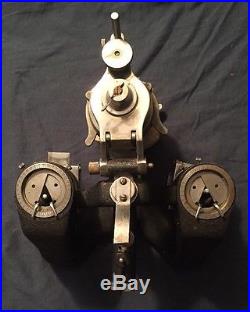
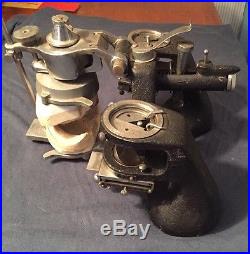
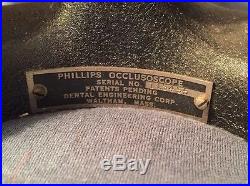
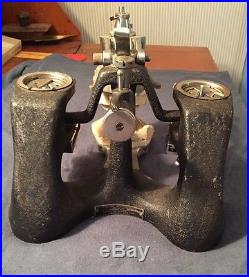
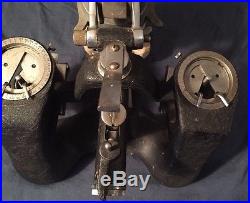
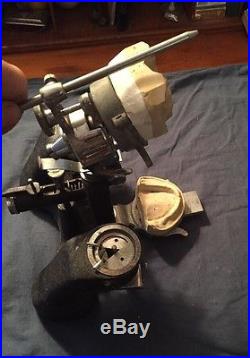
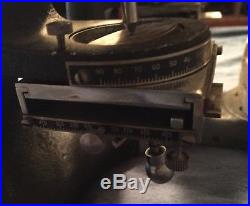
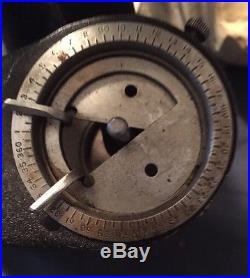
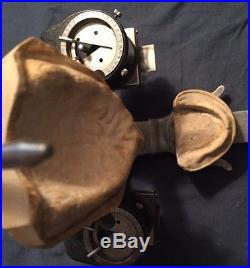
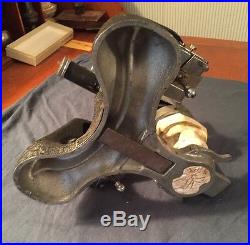
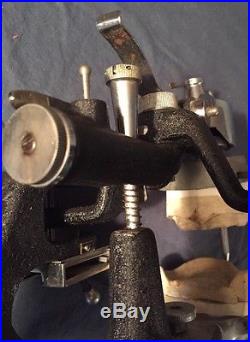
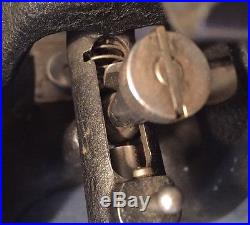
Looking at the pictures available it appears that all the pieces are here. As I know nothing about this other than the research I did, I cannot guarantee it so look at the photos closely and ask questions. This item was patented in 1937. The equipment tag on this indicates “Patent Pending” so I assume this is pre-1937. Packed weight will be between 8 and 9 pounds. Dental Engineering Corporation, Waltham , MA. This is the original design for the Occlusoscope that was patented in 1937. It was later simplified. As was Phillips’ earlier articulator designs, the purpose of the Occlusoscope was to record mandibular movement obtained with his Gothic Recorder, an extra-oral gothic arch tracer with a central bearing point. The central bearing point was an innovation presented by Phillips to the dental profession in 1926. The lower member or stand of this instrument projects forward to include a cast holder and flat incisal table. The upper T-shaped member is centrally connected to the stand through a spring loaded universal ball and sliding barrel joint. The occlusal vertical dimension can be changed or a retrusive movement can be made with this device. The upper member is also supported by two vertical pins that function within lateral (condylar) units. In these units the vertical pins rest on horizontal (glenoid fossae) discs that control the vertical displacement and are guided horizontally by gothic arch-forming adjustable blades. The upper cast holder features a universal joint carriage for adjusting the position of the upper cast and a simple hinge joint allows working access to the casts. Anterior to the cast holder is an incisal pin resting on a flat incisal guide table. Phillips GP: Use of the Occlusoscope. Part of patent application. Try the new Google Patents, with machine-classified Google Scholar results, and Japanese and South Korean patents. Referenced by (14), Classifications (8). External Links: USPTO, USPTO Assignment, Espacenet. (OCR text may contain errors). PHILLIPS DENTAL INSTRUMENT 2 Sheets-Sheet 1 Filed June 7, 1934 Feb. PHILLIPS DENTAL INS TRUMENT 2 Sheets-Sheet 2 Filed June 7, 1954 Patented Feb. 9, 1937 UNlTED STATES PATENT OFFICE 12 Claims. This invention relates to scientific instruments designed for use in the study of the physiology of the human jaws and teeth and their relation to each other. Full chewing efficiency results from the coordination of the curved occlusal tooth planes in correct relation to the forces exerted by the functicning muscles of mastication, and consequently many of the problems with which the dentist must deal have to do with abnormalities in the anatomy or functions of the jaws and teeth. Mechanically considered, the human masticatory apparatus, when in function, moves in three dimensions describing arcs within these dimensions from a multiplicity of centers of rotation. This invention aims to devise an instrument with the aid of which these arcs or paths of movement may be determined and reproduced and which will facilitate the correction of functional and anatomic abnormalities of the jaws. The nature of the invention will be readily understood from the following description when read in connection with the accompanying drawings, and the novel features will be particularly pointed out in the appended claims. Figure 1 is a plan view of an instrument constructed in accordance with this invention. 2 is a side elevation of the instrument shown in Fig. 3 is a sectional view through a portion of the instrument. L and 5 are plan and sectional views illustrating a modification. 6 and 7 are sectional views approximately on the lines 0 and 1-1, respectively, Fig. 8 is a front elevation of the parts shown in Fig. 9 and 10 are horizontal and vertical sectional views, respectively, of the universal joint. The instrument shown in the drawings comprises a stand 2 designed to rest on a table or other suitable support. It includes a forwardly projecting arm which terminates in a clamp 3 designed to hold the lower jaw cast. Mounted on the stand 2 is a carriage 4 provided with a forwardly extending arm 5 which carries an upper clamp B for holding the upper jaw cast. The carriage is mounted for floating or bodily movement in a horizontal plane and also for limited movement transversely to said plane. As above indicated, an important function of instruments of this type is to reproduce the relative movements of the jaws. These movements involve not only forward, backward and lateral components, but also additional components in diagonal planes, and the extent and direction of such movements necessarily vary with different individuals. Consequently, to reproduce such movements accurately and in the ranges necessary to accommodate the great variety of conditions found in patients, is an important functicn of this instrument. This requirement introduces unusual problems in the relative guiding of the jaw casts. The guiding mechanism for the carriage 4 comprises two upright pins indicated, respectively, at l and 7, both secured rigidly to the upper horizontal arm of the carriage, and equally spaced laterally from the longitudinal median plane of the instrument. Both pins rest on rocking planes, each of which may be tipped forward, backward, or laterally, theoretically into an infinite number of vertical planes, all intersecting the axis of its respective pin. Since the rocking planes for the two pins are duplicates one of the other, a description of one only need be given. Referring more especially to Figs. 2 and 3, it will be seen that the rocking plane 8 for the pin 7 consists of a section of a sphere having an approximately fiat upper surface on which the ball end of the point of the pin 1 rests. While said upper surface can be a plane, it is preferable to make it very slightly concaved, the degree of concavity being somewhat exaggerated in the drawings. For practical purposes this entire guiding surface may be regarded as located approximately in a plane bisecting the sphere, the center of the sphere normally lying in the axis of the pin 1. This hemispherical member 8, which usually is referred to as a rocking plane, or as the horizontal rocking plane, is mounted in a tapered socket 9 formed in a portion of the stand 2, or more conveniently in a bushing ll threaded into the arm a of the stand 2, the socket being of frusto-conical form. For the purpose of adjusting the rocking member 8 and holding it in any position to which it may be adjusted, a stem 10 is secured rigidly in it and projects downward radially therefrom through av slide or plate l2 with Which the stem has a sliding fit. The connection between the stem and the slide preferably includes a ball I3 through which the stem slides, the ball having a rotary fit with the slide 12 but being held against it by a spring I5 which encircles the stem l0 and bears at its upper end against the ball and at its lower end against a handle l6 threaded on the lower end of the stem. The slide I2 is mounted to run in guideways formed in a second slide I! Which is mounted to slide in a direction transverse to the direction of the sliding movement of the part l2, the slide l1, however, carrying the slide i2. By moving the handle l6, therefore, the plane 8 may be rocked in its socket into any one of a multitude of vertical planes, each intersecting the center of the member 8. It can also be swung into any one of a great variety of angular positions in any selected one of said vertical planes. During such movements the spring I5 holds the member 8 bottomed in its socket. The two slides I2 and I? Serve to resolve the movements of the rocking member into its two horizontal components. Consequently, by suitably graduating these slides or parts adjacent to them, and associating pointers with them, an accurate designation of any adjustment of the member 8 may be made. As shown in’Fig. 2, the edge of the slide I1 is graduatedin degrees and a pointer l8, Fig. 8, secured to the slide I2 is arranged to run along the lower edge of said graduations as the slide is moved. Another scale, similarly graduated, is secured to the front face of the slide I I, as shown in Fig. 8, and cooperates with a center mark on a stationary part of the instrument to designate the adjustment of the slide I! In either direction away from its central position. A thumb screw I9, Figs. 1, 3 and 8, is threaded through a portion of the slide I! And is arranged to bear against a stationary part of the instrument to lock this slide in its adjusted position, while another thumb screw 28 is threaded through the slide I! And is arranged to engage the edge ofthe plate I2 to lock the latter in its adjusted location. Parts corresponding to those cooperating with the pin I are provided to cooperate with the other pin 1′ at the opposite side of the instrument, and these parts have been designated by corresponding, but primed, numerals. With this arrangement, therefore, it is a simple matter for the user of the instrument to adjust the planes into the positions necessary to suit the requirements of any individual case, to make a record of those positions, and thereafter to reproduce the same adjustment with a high degree of accuracy. The planes 8 and 8′ determine the plane of the path of movement of the carriage, or, in other words, the angular relationship of said path to a horizontal plane. In order to guide the carriage along the desired path or paths in a horizontal plane or in any plane of inclination determined by the members 88′, a pair of circular plates, each provided with a knife edge, is arranged to engage the stem I immediately above the plane 8. As shown in Figs. Two small bolts 24, 25, Fig. 7, secure the holder in a fixed, stationary position and hold the plates in the part 23. These two plates thus may be adjusted so that their knife edges, which engage the stem 1, will define any one of a great variety of angular paths in which the stem can be guided while its lower end rides over the surface of the rocking plane 8. A scale 26, Fig. 1, engraved on the edge of the holder 23, cooperates with pointers 21 and 28, Fig. 7, on the respective plates, to designate the angular positions of the plates for convenience in making a record of the setting required for any individual case. The various parts above described which cooperate with the pin I are duplicated at the other side of the machine to co-a-ct in the same manner with the pin 7. It is of advantage to be able to rotate the member 8 around the axis of the spindle, together with the slides I2 and I1, while maintaining the relationship of the member 8 to the slides undisturbed. An arrangement suitable for this purpose is illustrated in Figs. 2, 3 and 8 in which an intermediate member 29 is secured to the lower face of the arm a by the socket member a II. This socket member is made of circular outline and is flanged to receive and hold the part 29, while the latter is grooved to support the slide IT. The second slide I2 is carried by the first slide as above described. This arrangement, however, permits the rotation of the part 29, with the slides mounted on it, about the axis of the pin 7 without disturbing the adjustment of the member 8. Normally the member 29 is locked in a stationary position by means of a thumb screw 38, Figs. 2 and 8, threaded through the arm a and bearing against the upper surface of the member 29. A scale 3I-, Figs. 2 and 8, secured to the forward curved end of the arm a cooperates with a center mark 32, Fig. 8, on the intermediate member 29 to designate the degree of angular adjustment of the latter member. In some instruments which do not require the refinements of the instrument shown in Figs. 2 and 3, a simpler arrangement for supporting the rocking planes may be used. One such construction is illustrated in Figs. 4 and 5-and comprises a rocking plane 34, similar to the member 8, supported in a hemispherical socket formed in the upper surface of a socket member 35 which is mounted on a suitable stand 36. Adjustment of the member 34 into any desired angular position may be made by suitably manipulating screws 31. 38 and 39 located apart around the margin of the rocking member 34. As shown in Fig. Each of the other screws 38 and 39 are likewise connected with similar fingers 42 and 43, so that by properly manipulating the three screws the member 34 may be adjusted into any angular position within the limits of this construction. The degree of adjustment so produced can be measured by suitable graduations on the edges of the guides for the slides, or, by making two semicircular rows of graduations, each on great circles of the hemispherical socket in which the member 34 rocks, these two circular lines of graduations being at right angles to each other. For the purpose of reproducing relative retrusive and protrusive movements and opening and closing movements of the jaws without the loss of normal relations, a post 45, Figs. 1, 2 and 6, is fixed rigidly in the. Frame or stand 2 and a ball 46 is slidably mounted on it, this ball being received in a tubular extension 41 projecting rearwardly from the carriage 4. Preferably this extension is a separate piece from the carriage and is provided at its forward end with a horizontally flattened end face to fit against a similar face of the carriage. These parts are secured together by a pivot screw 58, thus providing a joint which permits relative lateral movement between the main part of the carriage and the extension 41. A thumb screw 5I, threaded on the screw 50 looks both of these parts rigidly together, when desired. The extension 41 can slide freely backward and forward on the ball 46, and the ball can be moved with the extension up and down on the post 45, the upper limit of this movement being predetermined, when desired, by means of a thumb nut 53 threaded on to the post. This ball may also be used conveniently as a stop in producing the relative protrusive and retrusive movements of the dentures. 6, a spring 52 is enclosed in the tubular extension 4′! And abuts at one end against a plate 56, slidable in said extension, and at its opposite end against the end of the bore in said extension. Consequently, this spring tends to force the ball and the carriage apart, and thus to maintain the inner end of the screw 57 against the ball. The screw itself does not directly engage the ball but it carries an internal screw 58 which does bear against the ball. However, this inner screw 58 is used only in making the initial adjustment and thereafter turns with the screw 51 so that so far as the normal functional movements of the screw 51 are concerned, the member 58 is a part of it. It will be evident from an inspection of Figs. 2 and 6 that if the screw 57 is turned inwardly it will act against the ball 46 as a stop to draw the entire carriage and the upper jaw cast backwardly, thus producing a relative protrusive movement of the lower jaw. 1 is operatively associated with this screw, the extent of the said protrusive movement may be measured. It will also be evident that if the screw 51 is backed up, it will permit the entire carriage and the upper denture to slide forwardly and such a sliding movement will be produced by the spring 52 whichserves to hold the plate 56 constantly against the ball 46. Frequently it is important in making these movements to be able to come back quickly to a zero position. This position may conveniently be fixed by means of a spring pressed pin 62, Fig. 6, slidable freely in a portion of the extension 41, the lower end of this pin being adapted to enter a hole drilled radially in a smooth or non-threaded part of the screw 51. The initial zero adjustment is made with the pin 62 looking the screw 51 against rotation, as shown in Fig. 6, and then turning the inner screw 58 inward or outward, as desired, until the carriage is brought into its central or zero relationship to the stationary parts of the instrument. Then is locked in its adjusted position by means of a set screw. Thereafter the screw 51 may be freed from the locking pin whenever desired by lifting the latter and the end of this pin will simply ride on the smooth unthreaded portion of the screw until the latter is brought back again to its zero position. When it is desired to make the movements of the carriage as free as possible, the plate 56 may be moved forward to compress the spring 52, after which its ends, which are relatively narrow and flat, are forced into notches 63, which look the plate and thus hold the spring in a compressed condition. Several pairs of these notches provide for the locking of this plate in different positions. It will be observed that in this instrument the movements of the carriage, and consequently of the upper jaw cast, are guided by the engagement of the lower ends of the pins 1 and l with the horizontal planes 8 and 8. Since these rocking planes can be adjusted into a horizontal plane or any angle of inclination (within the limits of the instrument) with reference to such a plane, an almost infinite variety of angular paths of movement may be produced. The direction of any desired pat. The item “Vintage 1936 Dental Equipment Phillips Occlusoscope Articulator Pre Patent Appr” is in sale since Thursday, October 27, 2016. This item is in the category “Business & Industrial\Healthcare, Lab & Life Science\Dental Equipment\Dental Lab\Articulators”. The seller is “ricksbjr” and is located in Bristol, Connecticut. This item can be shipped to United States.
 Posted in
Posted in 

